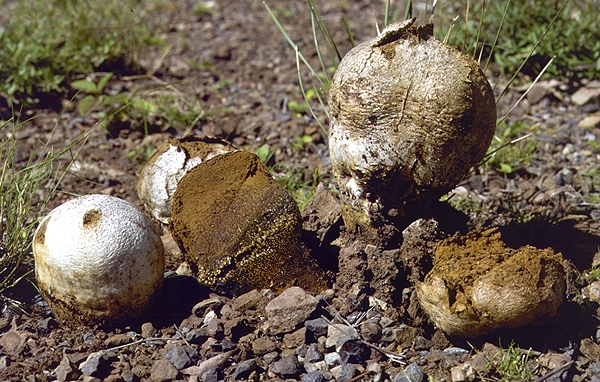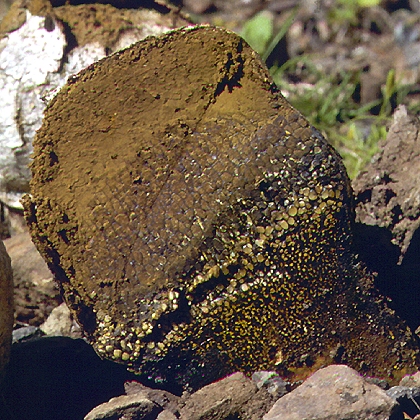
Pisolithus sp.

Common name: A similar species in Europe is called the Horse Droppings Fungus.
Description: The large, ball-like fruiting bodies are commonly 610 cm in diameter but may reach 12 cm or even more. The fungus is at first white with a thin outer skin which is easily damaged and bruises dark brown to tar-black and may stain the fingers yellowish if touched. As the fungus matures, the outer skin and the whole upper section begins to disintegrate into a powdery brown spore mass but the lower section remains firm. The interior of the ball contains the powdery spore mass at the top but this progresses into a solid region which is seen to contain large numbers of rice grain sizes particles (peridioles) cemented together with a soft, blackish or dark brown material that stains the fingers yellowish. The peridioles contain the spore-producing cells, and when the spores are mature, the skin of the peridiole disintegrates to release the spores. The ball is held upon a stem that may be more or less buried in the soil but when visible is dirty white to brownish with a bright yellow interior. The above-ground portion of the stem is usually 34 cm long, up to 3 cm thick and is dry, solid and cylindrical. The interior of the stem stains yellowish. If held in the hand, the fungus feels quite heavy for its size.
The spores measure 814 µm in diameter and are globose, spiny, and brown in mass.
Substratum: This species of Pisolithus is most commonly found in hard, stony gravel at the side of bitumen roads in eucalypt forest or woodland. In some cases, the fungus may even push up the bitumen and has been found in similar positions in school playgrounds.
Distribution: This fungus is found in all eastern mainland states and Tasmania. It also occurs in Western Australia.
Notes: Species of Pisolithus occur world-wide and one in particular, P. tinctorius, has been used to produce a very good yellow dye for wool; experiments with the Australian species have not been as successful. The Australian species was originally published under the name of Polysaccum album Cooke & Massee and its transfer to the genus Pisolithus will be done as part of a revision of all the Australian species by M.J.Priest. Old fruiting bodies look particularly tatty when seen in the roadside gravel in quantity. Eventually, the fungus disintegrates so much that only a stump of a stem is left behind. This species is supposedly edible although possibly not to European taste. An old black and white film of a trip across the Nullarbor Plain during the 1930s shows a small truck halting on a track and Aborigines collecting and eating what is, presumably, this fungus.

